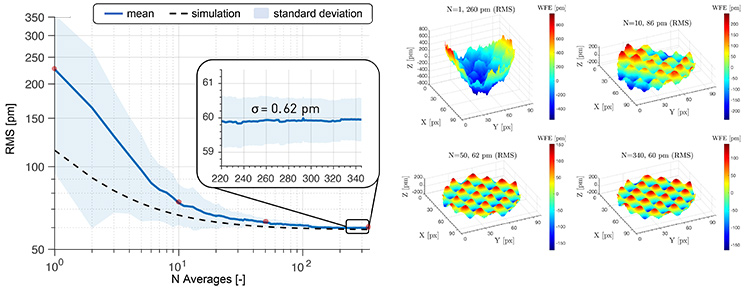 Left: RMS surface figure error (in pm), plotted as a function of the number of averaged differences. The light-blue envelope shows the repeatability of the measurement. After 100 averages (~4.3 seconds), the system has reached a repeatability of 1.6 pm, and most atmospheric residuals have averaged out. After this point, repeatability reduces by the square root of the number of averages (consistent with photon noise). Right: Surface figure plots of the optic under test for different levels of averaging.
Left: RMS surface figure error (in pm), plotted as a function of the number of averaged differences. The light-blue envelope shows the repeatability of the measurement. After 100 averages (~4.3 seconds), the system has reached a repeatability of 1.6 pm, and most atmospheric residuals have averaged out. After this point, repeatability reduces by the square root of the number of averages (consistent with photon noise). Right: Surface figure plots of the optic under test for different levels of averaging.
Precision optical wavefront metrology is crucial in areas of science, industry and fundamental research ranging from microlithography to quantitative microscopy to gravitational-wave observatories. Direct imaging of exoplanets also requires stringent wavefront sensing and control over the full collecting aperture at the picometer scale.1 Although ground-based systems can make such measurements, similar systems that are suitable for space use, and that can use stellar photons for sensing, are still lacking.
The Zernike phase-contrast technique2 is well suited for this measurement due to its intrinsic simplicity, robustness and sensitivity. The key element of this sensor is a dimple, approximately λ/D in diameter and λ/4 in optical depth, etched into a glass substrate. This device is placed at an intermediate focal plane just in front of a pupil-viewing camera. The point-spread function at this focal plane is centered on the phase-contrast mask. The result is a common-mode interferometer in which the DC portion of the light is phase-shifted with respect to its high-order portions. In the subsequent pupil plane, the phase errors in the input pupil plane are encoded as intensity errors. This method has been used to measure larger-magnitude, lower-spatial-frequency errors like tip/tilt and focus.3,4
In work published this year,5 we have developed a more robust phase reconstruction expression that allows very accurate measurement of small phase changes at the highest spatial frequencies possible (set by the number of pixels illuminated at the final pupil-imaging detector). We also have targeted very small signals to demonstrate its applicability for space-based high-contrast missions.
The measurement repeatability in our testbed is limited by photon noise and atmospheric phase turbulence. We address atmospheric turbulence by making quick measurements in succession with the deformable mirror (DM) nominally flat, and then with a waffle pattern, whereby every other DM actuator is activated. Differencing of these frames allows us to remove the quasi-static portion of the atmosphere; averaging these differences reduces the remaining atmospheric residual over time, as well as the effect of photon noise.
Our results demonstrate that the phase-contrast technique can serve as a powerful method of wavefront sensing, and achieves incredible levels of precision in a simple architecture.
Researchers
John Steeves, J. Kent Wallace, Christian Kettenbeil and Jeffrey Jewell, Jet Propulsion Laboratory, California Institute of Technology, Pasadena, CA, USA
References
1. S.B. Shaklan et al., in Space Telescopes and Instrumentation I: Optical, Infrared, and Millimeter, vol. 6265, p. 62651I (SPIE, 2006).
2. F. Zernike. Mon. Notices Royal Astron. Soc. 94, 377 (1934).
3. M. N’Diaye et al. Astron. & Astrophys. 555, A94 (2013).
4. F. Shi et al. J. Astron. Telesc. Instrum. Syst. 2, 1 (2016).
5. J.B. Steeves et al. Optica 7, 1267 (2020).
